ICCV 2023 prime papers, common tendencies, and private picks

I used to be fortunate and privileged sufficient to attend the ICCV 2023 convention in Paris. After accumulating papers and notes I made a decision to share my notes together with my favorite ones. Listed below are the very best papers picked out together with their key concepts. When you like my notes beneath, share them on social media!
In the direction of understanding the connection between generative and discriminative studying
Key thought: A really new pattern that I’m extraordinarily enthusiastic about is the connection between generative and discriminative modeling. Is there any shared illustration between them?
The authors reveal the existence of matching neurons (rosetta neurons) throughout completely different fashions that categorical a shared idea (corresponding to object contours, object components, and colours). These ideas emerge with none supervision or guide
annotations.Supply
Sure! The paper “Rosetta Neurons: Mining the Frequent Models in a Mannequin Zoo” confirmed that utterly completely different fashions pretrained with utterly completely different goals study shared ideas (corresponding to object contours, object components, and colours). These ideas emerge with none supervision or guide annotations. I had solely seen object-related ideas emerge on the self-attention maps of self-supervised imaginative and prescient transformers corresponding to DINO to this point. They additional present that the activations look related, even for StyleGAN2.
The method might be briefly described as follows: 1) use educated generative mannequin to supply photographs, 2) feed the picture right into a discriminative mannequin and retailer all activation maps from all layers, 3) compute Pearson correlation averaged over photographs and spatial dimensions, 4) discover mutual nearest neighbors between all activations of the 2 fashions, 5) cluster them.
Pre-pretraining: Combining visible self-supervised coaching with pure language supervision
Motivation: The masked autoencoder (MAE) randomly masks 75% of a picture and trains the mannequin to reconstruct the masked enter picture by minimizing the pixel reconstruction error. MAE has solely been proven to scale with mannequin measurement on ImageNet.
However, weakly supervised studying (WSL) that means pure language supervision has a textual content description for every picture. WSL is a middle-ground between supervised and self-supervised pretraining, the place textual content annotations are used, corresponding to CLIP.
Key thought: Whereas MAE thrives in dense imaginative and prescient duties like segmentation, WSL learns summary options and has a exceptional zero-shot efficiency. Can we discover a method to get the very best of each worlds?
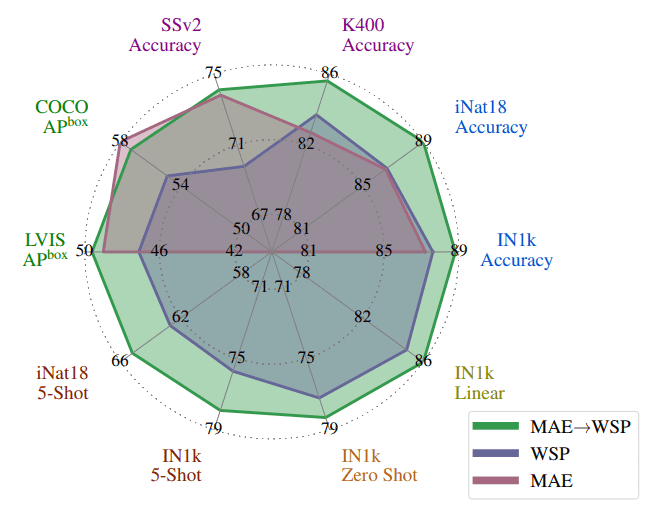
MAE pre-pretraining improves efficiency. Switch efficiency of a ViT-L structure educated with self-supervised
pretraining (MAE), weakly supervised pretraining on billions of photographs (WSP), and our pre-pretraining (MAE –> WSP) that initializes
the mannequin with MAE after which pretrains with WSP. Pre-pretraining
constantly improves efficiency. Supply
Meta AI exhibits that it’s attainable of their work “The effectiveness of MAE pre-pretraining for billion-scale pretraining”.
Key thought: Mix MAE self-supervised (1st stage → pre-pretraining) and weakly-supervised studying (2nd stage pretraining). This mix referred to as MAE→WSP outperforms utilizing both technique in isolation, i.e., an MAE mannequin or a weakly supervised mannequin educated from scratch.
Adapting a pre-trained mannequin by refocusing its consideration
Since foundational fashions are the best way to go, discovering intelligent methods to adapt them to numerous downstream duties is a important analysis avenue.
Researchers from UC Berkeley and Microsoft Analysis present that it may be achieved by a TOp-down Consideration STeering (TOAST) strategy of their paper “TOAST: Switch Studying through Consideration Steering”.
Key thought: Given a pretrained ViT spine, they tune the extra linear layers of their methodology that act as suggestions paths after the first ahead cross. As such the mannequin can redirect its consideration to the task-relevant options and as proven beneath it might outperform normal fine-tuning (75.2 VS 60.2% accuracy).
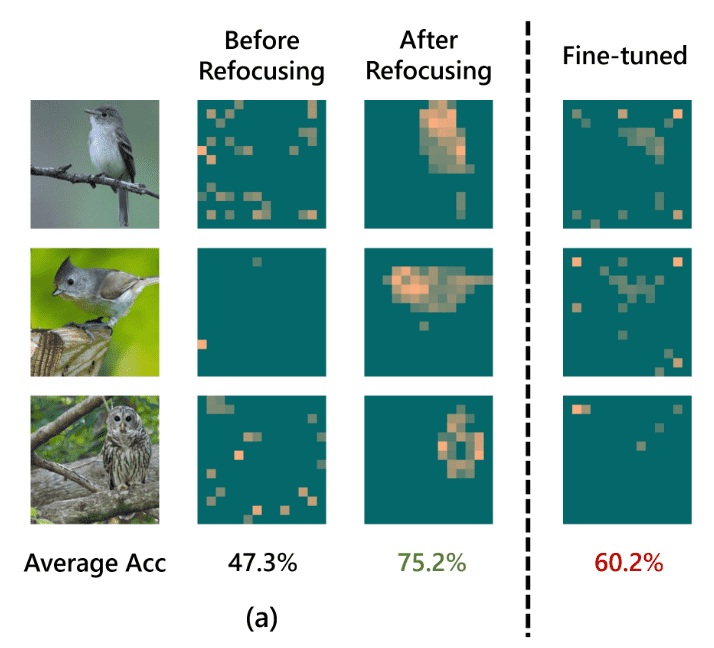
An ImageNet pre-trained ViT is used for downstream hen classification utilizing completely different switch studying algorithms. Right here they visualize the eye maps of those fashions. Every
consideration map is averaged throughout completely different heads within the final layer of ViT. Supply
Intuitively, the top-down alerts (after the first feedforward cross) will choose and propagate the task-relevant options in every layer, and the 2nd feedforward can have entry to these enhanced options, reaching stronger efficiency.
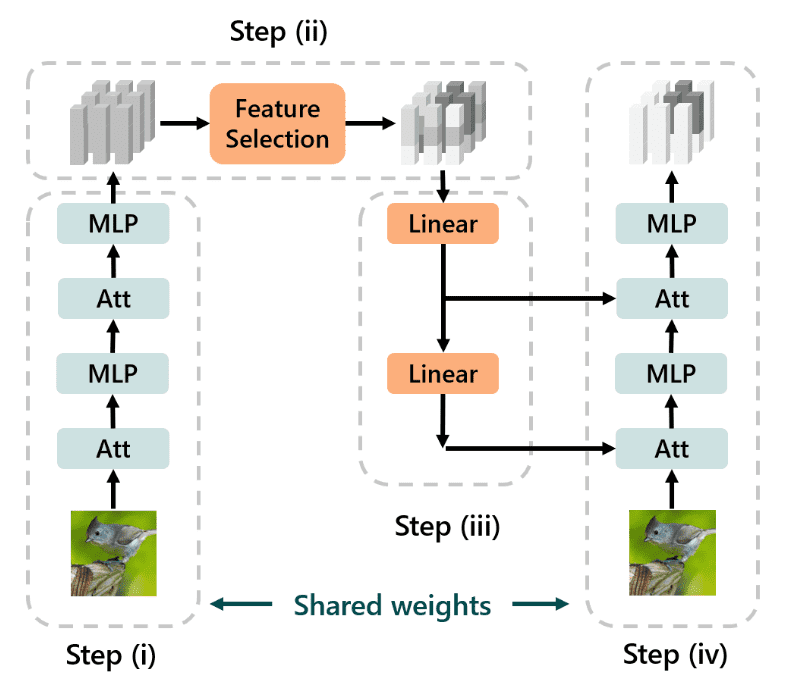
Inference has 4 steps: (i) the enter goes by way of the feedforward
transformer, (ii) the output tokens are softly reweighted by the function choice module primarily based on
their relevance to the duty, (iii) the reweighted tokens are despatched again by way of the suggestions path, and
(iv) we run the feedforward cross once more however with every consideration layer receiving further top-down
inputs. Through the switch, we solely tune the options choice module and the suggestions path and
hold the feedforward spine frozen. Supply:TOAST
In case you are to study extra about top-down consideration the identical group has printed related work in CVPR.
Picture and video segmentation utilizing discrete diffusion generative fashions
Google DeepMind offered an intriguing work referred to as “A Generalist Framework for Panoptic Segmentation of Photos and Movies”.
Key thought: A diffusion mannequin is proposed to mannequin panoptic segmentation masks, with a easy structure and generic loss perform. Particularly for segmentation, we wish the category and the occasion ID, that are discrete targets. Because of this, the notorious Bit Diffusion was used.
“Bit Diffusion first converts integers representing discrete tokens into bit-strings, the bits of that are then forged as actual numbers (a.ok.a., analog bits) to which steady diffusion fashions might be utilized. To attract samples, Bit Diffusion makes use of a standard sampler from steady diffusion, after which a closing quantization step (easy thresholding) is used to acquire the explicit variables from the generated analog bits.” ~ Chen et al.
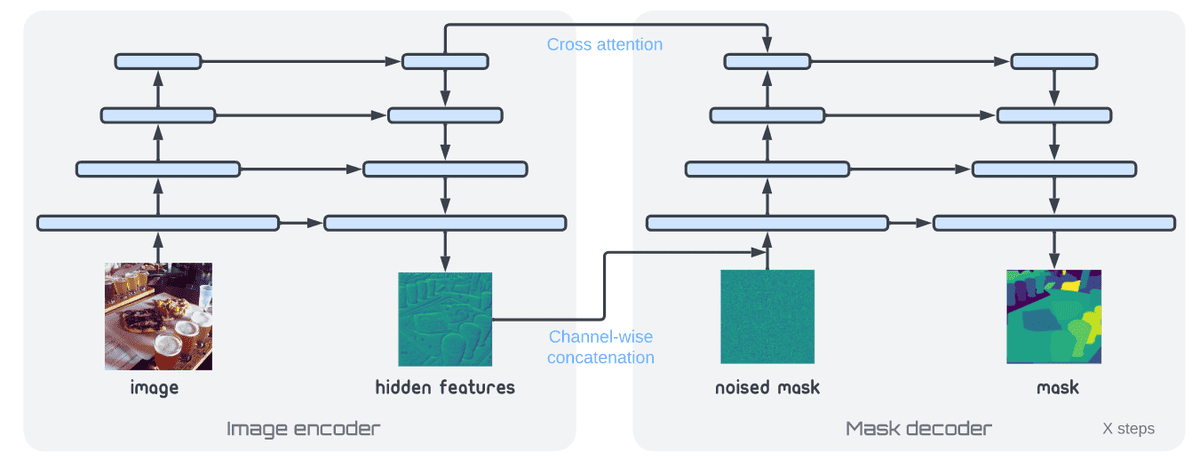
The structure for the proposed panoptic masks technology framework. We separate the mannequin into picture encoder and masks decoder in order that the iterative inference at take a look at time solely includes a number of passes over the decoder. Supply
The diffusion mannequin is pretrained unconditionally to supply the segmentation masks after which the pretrained picture encoder plus the diffusion mannequin are collectively educated for conditional segmentation.
Crucially, by merely including previous predictions as a conditioning sign, our methodology is able to modeling video (in a streaming setting) and thereby learns to trace object cases routinely.
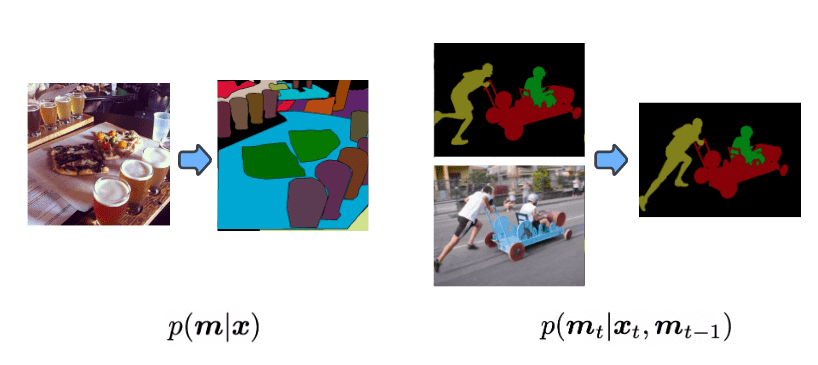
The authors formulate panoptic segmentation as a conditional discrete masks (m) technology drawback for photographs (left) and movies (proper), utilizing a Bit Diffusion generative mannequin. Supply
Amazingly, it really works out of the field. The mannequin routinely learns to trace and section cases throughout frames when incorporating the past-conditional technology.
This strategy performs inferior to task-specific approaches, however provided that each structure and loss features are task-agnostic the outcomes are spectacular.
Diffusion fashions for stochastic segmentation
In a proximal work, researchers from the College of Bern confirmed that express diffusion fashions can used for stochastic picture segmentation of their work titled “Stochastic Segmentation with Conditional Categorical Diffusion Fashions”.
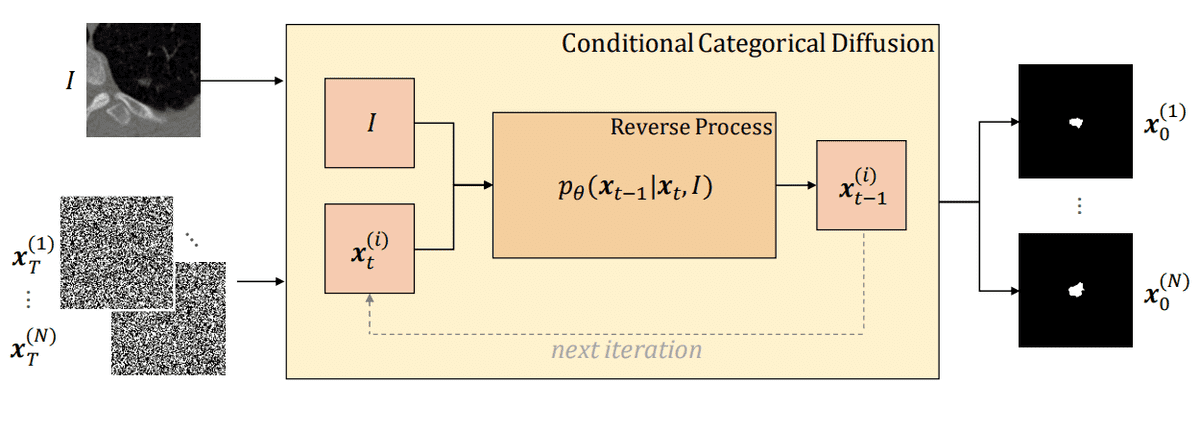
Illustration of the reverse technique of our methodology. The conditional categorical diffusion mannequin (CCDM) receives as enter a picture I and a categorical label map sampled from the explicit uniform noise. Supply
If you wish to study extra about categorical diffusion, here’s a paper presentation from NeurIPS 2021.
Diffusion fashions: changing the commonly-used U-Internet with transformers
The paper “Scalable Diffusion Fashions with Transformers” exhibits that one can use transformers throughout the diffusion framework and acquire aggressive efficiency on class-conditional ImageNet benchmarks as much as 512×512 decision.
The motivation behind that is that transformers/ViTs have the very best practices and scaling efficiency and have been proven to scale extra successfully for visible recognition than conventional convolutional networks, the primary constructing block of U-nets in present diffusion fashions.
Key thought: Briefly, the authors present that by establishing and benchmarking the Diffusion Transformers (DiTs) design house underneath the Latent Diffusion Fashions (LDMs) framework, the place diffusion fashions are educated inside a VAE’s latent house, one can efficiently substitute the U-Internet spine with a transformer. They additional present that DiTs are scalable architectures for diffusion fashions: there’s a sturdy correlation between the community complexity (measured by Gflops) vs. pattern high quality (measured by FID).
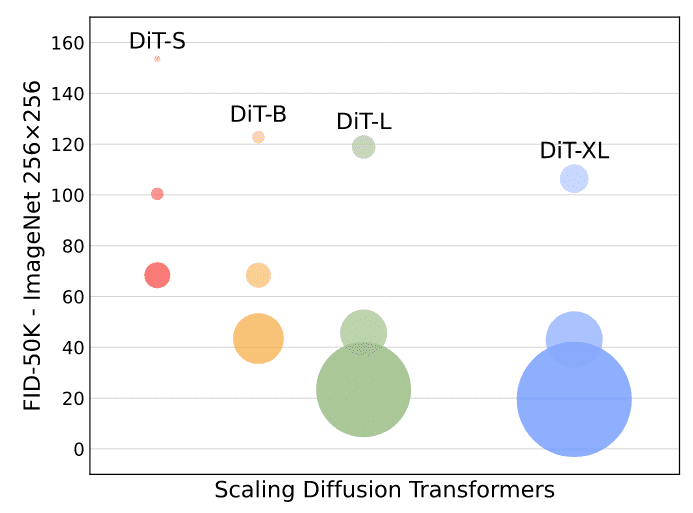
ImageNet technology with Diffusion Transformers (DiTs). Bubble space signifies the flops of the diffusion mannequin. Left:
FID-50K (decrease is best) of our DiT fashions at 400K coaching iterations. Efficiency steadily improves in FID as mannequin flops enhance.Supply
Diffusion Fashions as (Delicate) Masked Autoencoders
Sander Dieleman has already talked concerning the connection between diffusion fashions and denoising autoencoders (excluding bottleneck, and together with the a number of noise ranges) on this weblog submit.
Key thought: On this path, the paper Diffusion Fashions as Masked Autoencoders proposes conditioning diffusion fashions on patch-based masked enter. Usually the noising was going down pixel-wise in normal diffusion, which might be considered tender pixel-wise masking.
However, the masked autoencoder was receiving masked pixels, a sort of laborious masking as pixels are merely zeroed. By combining these two, the authors formulate diffusion fashions as masked autoencoders (DiffMAE).
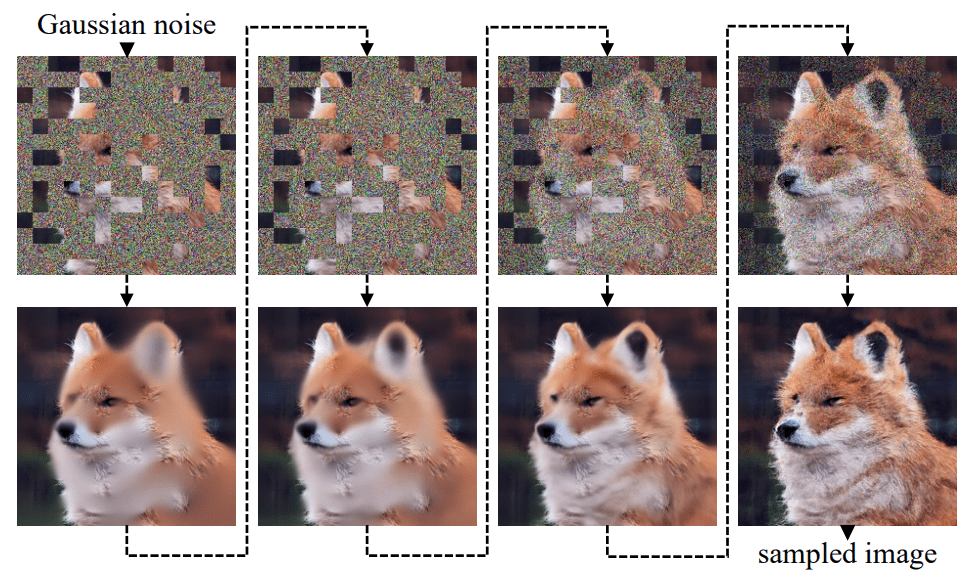
Inference technique of DiffMAE, which iteratively unfolds from random Gaussian noise to the sampled output. Throughout coaching, the mannequin learns to denoise the enter at completely different noise ranges (from prime row to the underside) and concurrently performs self-supervised pre-training for downstream recognition. Supply
The encoded options can function an initialization for fine-tuning downstream duties and produce state-of-the-art video classification accuracy. Notably, the decoder is bigger than the MAE will some further cross attentions/skip connections are used.
Denoising Diffusion Autoencoders as Self-supervised Learners
Visible illustration studying is bettering from all completely different instructions corresponding to supervised studying, pure language weakly supervised studying, or self-supervised studying. And any longer with Diffusion Fashions!
In the same analysis path to the Diffusion-MAE, the paper “Denoising Diffusion Autoencoders are Unified Self-supervised Learners” discovered that even the usual unconditional diffusion fashions might be leveraged for illustration studying just like self-supervised fashions.
Key thought: Extra concretely, by pre-training on unconditional picture technology, diffusion fashions are already capturing linear-separable representations inside their intermediate layers, with out modifications.
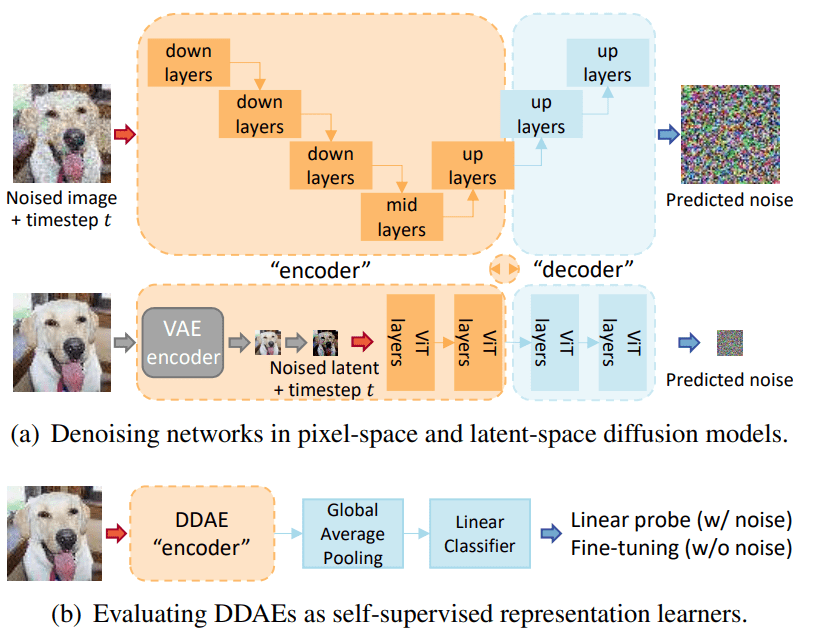
Denoising Diffusion Autoencoders (DDAE). Prime: Diffusion networks are basically equal to level-conditional denoising autoencoders (DAE). The networks are named as DDAEs because of this similarity. Backside: By linear probe evaluations, we verify that DDAE can produce sturdy representations at some intermediate layers. Truncating and fine-tuning DDAE as imaginative and prescient encoders additional results in superior picture classification efficiency. Supply
This work is necessary because it unifies the beforehand unrelated fields of generative and discriminative studying. Limitations and necessary components of this strategy are that the function high quality closely will depend on layer depths and noising scales.
For instance on CIFAR-10 the very best options lie in the midst of the Unet decoded, when photographs are perturbed with small noises.
The authors point out that coaching diffusion fashions are extraordinarily pricey and that finest practices in discriminative illustration studying (e.g. BYOL, DINO) could encourage developments that can scale the coaching of diffusion fashions.
Leveraging DINO consideration masks to the utmost
This work is wonderful because it makes use of the eye masks from the self-supervised methodology DINO to carry out zero-shot unsupervised object detection and even occasion segmentation!
Key thought: They suggest a easy framework referred to as Lower-and-LEaRn (CutLER). They leverage the property of self-supervised fashions to ‘uncover’ objects with out supervision (of their consideration maps). They post-process these masks to coach a state-of-the-art localization mannequin with none human labels. The post-processing is predicated on a classical pc imaginative and prescient algorithm referred to as normalized graph cuts and it appears to generate excellent masks.
Normalized Cuts (NCut) treats the picture segmentation drawback as a graph partitioning process. We assemble a completely linked undirected graph by representing every picture as a node. Every pair of nodes is linked by edges with weights Wij that measure the similarity of the linked nodes.

An illustration of tips on how to uncover a number of object masks in a picture with out supervision. The authors construct upon earlier works and create a patch-wise similarity matrix for the picture utilizing a self-supervised DINO mannequin’s options. Subsequently they apply Normalized Cuts to this matrix and acquire a single foreground object masks of the picture. They then masks out the affinity matrix values utilizing the foreground masks and repeat the
course of, which permits the algorithm to find a number of object masks in a single picture. On this pipeline illustration this course of is repeated 3 instances.
Then a detector is educated with these masks, whereas self-training additional improves the efficiency.
Generative studying on photographs: can’t we do higher than FID?
On the path of different evaluations of generative fashions, I actually just like the strategy from the paper “HRS-Bench: Holistic, Dependable and Scalable Benchmark for Textual content-to-Picture Fashions” amongst different present ones, primarily primarily based on CLIP, and solely relevant for text-conditional picture technology.
Key thought: Measure picture high quality (constancy) by way of text-to-text alignment utilizing CLIP (the Picture Captioner mannequin G(I) within the determine beneath).
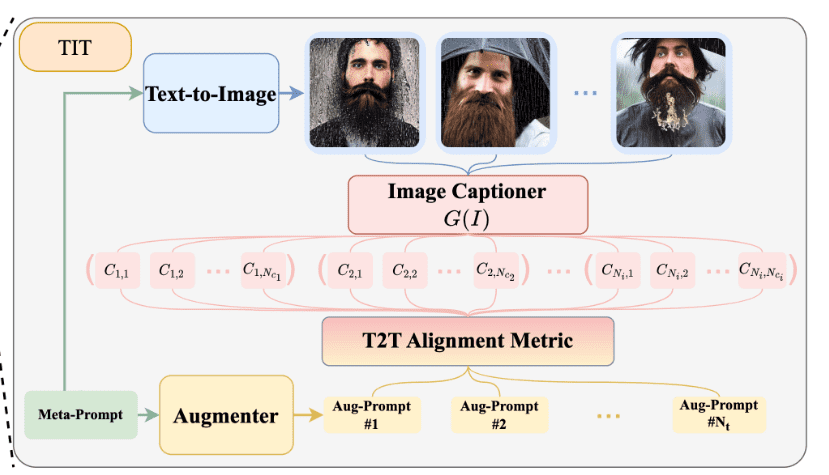
An instance of a substitute for FID utilizing CLIP and textual content to textual content similarity/alignment. Supply
Examples of text-to-text scores embody CIDEr and BLEU and they’re well-established within the NLP literature. I’m anticipating extra papers on this path and for numerous sorts of situations.
The paper has many extra evaluations concerning generative fashions.
Notice: Regardless that ImageBind and DINOv2 weren’t accepted papers in ICCV they have been offered within the sales space of Meta AI they usually have been closely mentioned throughout the week of the convention.
Meta AI has constructed an open-sourcing framework referred to as ImageBind of their paper “ImageBind: One Embedding House To Bind Them All”, the primary AI mannequin that brings collectively data coming from six completely different modalities in a single embedding house.
Key thought: The mannequin learns a single embedding, or shared illustration house, for textual content, photographs, audio, depth (3D), thermal (infrared radiation), and inertial measurement items (IMU). ImageBind creates a joint embedding house throughout a number of modalities while not having to coach on information with each completely different mixture of modalities.
How? Brief reply: Utilizing a transformer and a contrastive studying goal.
The shared embedding form allows multi-modal retrieval, an incredible new software. For example, we are able to retrieve within the shared function house sounds which might be semantically shut within the function house with the picture. Think about you may have a picture of the ocean with waves and you may retrieve related sounds such because the sound of the wave. And even get a 3D form from the depth sensor and so on.
Historically there’s a particular embedding (that’s, vectors of numbers that may characterize information and their relationships in machine studying) for every respective modality referred to as specialist on this context. ImageBind can outperform prior specialist fashions educated individually for one specific modality, as described in our paper, in addition to mix completely different types of data.
DINOv2: Information curation issues for self-supervised studying + scaling up DINO/iBOT
I’ve coated just a few instances the strategy of DINO within the weblog and lectures.
Key thought: DINOv2 builds upon one other framework referred to as iBOT that mixes cross-entropy from completely different augmented views with masks language modeling. They basically discover tips on how to pace up coaching and scale to bigger batch sizes.
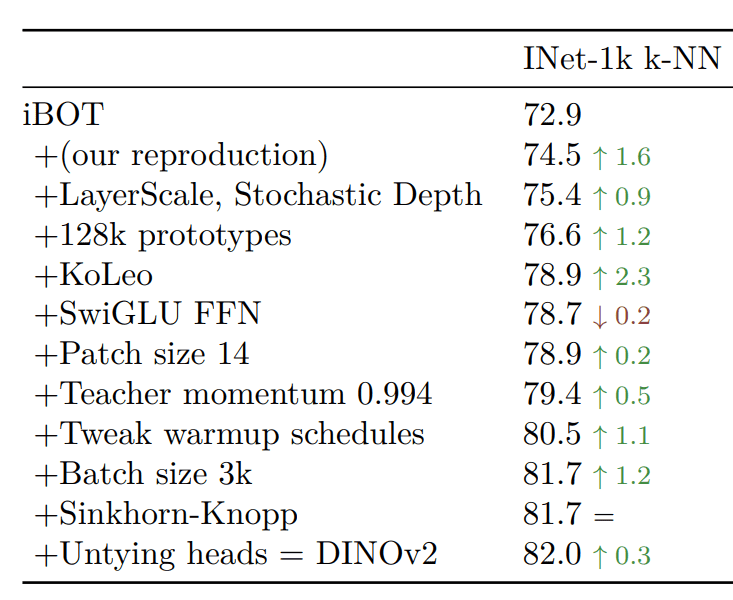
Ablation examine for the ViT-Giant structure on ImageNet-22k utilizing iBOT as a baseline. The authors select k-NN classification efficiency to optimize the efficiency. Supply
The second axis revolves round curating an unlabeled set of photographs for self-supervised studying. That is achieved with both k-means clustering (+sampling) on the function house of a big ViT mannequin pretrained on ImageNet-22K with DINOv2 or with easy k-nearest neighbors(NN) retrieval.
Miscalenous prime 10 private picks from ICCV2023
-
Sigmoid Loss for Language Picture Pre-Coaching: Another of the contrastive goal utilized in CLIP for large-scale pretraining with bigger batch sizes by avoiding the softmax normalization. The authors suggest a easy pairwise sigmoid loss for picture textual content pre-training. The brand new sigmoid-based loss operates solely on image-text pairs and doesn’t require a world view of the pairwise similarities for normalization.
-
Distilling Giant Imaginative and prescient-Language Mannequin with Out-of-Distribution Generalizability: This paper investigates the distillation from vision-language fashions (trainer) into light-weight pupil fashions on small datasets, together with open-vocabulary out-of-distribution (OOD) generalization. Contributions: (i) combines contrastive distillation (InfoNCE) loss between trainer and pupil with one other modified model of imply squared error (MSE) which appears one thing like
-
Preserve It SimPool: Who Mentioned Supervised Transformers Endure from Consideration Deficit?: a easy attention-based pooling mechanism as a substitute of the default one for each convolutional and transformer encoders that work for supervised and self-supervised studying approaches. SimPool improves efficiency on pre-training and downstream duties and offers high-quality consideration maps delineating object boundaries in all circumstances.
-
Unified Visible Relationship Detection with Imaginative and prescient and Language Fashions: This work focuses on coaching a single visible relationship detector (Unified Visible Relationship Detection by leveraging imaginative and prescient and language fashions) to foretell the union of label areas from a number of datasets. It tackles the difficulty of merging labels coming from completely different datasets utilizing the second-order visible semantics between pairs of objects.
-
An Empirical Investigation of Pre-trained Mannequin Choice for Out-of-Distribution Generalization and Calibration: spotlight the significance of pre-trained mannequin choice for out-of-distribution generalization. Imagenet-trained supervised ConvNeXt usually outperforms the opposite thought of fashions. A correlation between in-distribution and OOD generalization doesn’t at all times adhere to a linear growing sample, and the selection of dataset closely influences it.
-
Discovering prototypes for dataset comparability: Permits evaluating datasets by merely wanting on the photographs belonging to probably the most steadily realized prototypes. How: Makes use of DINO on the concatenation of two (or extra) datasets and goals to analyze the realized prototypes. By choosing probably the most steadily utilized clusters after coaching, one can establish that belong to one of many datasets or datasets or datasets that may share related semantic ideas.
-
Understanding the Function Norm for Out-of-Distribution Detection: proposes the utilization of function norms multiplied by the sparsity as a generic metric that may be mixed with k-NN distance for state-of-the-art OOD detection with ResNets/CNNs.
-
Benchmarking Low-Shot Robustness to Pure Distribution Shifts: 1) Self-supervised ViTs usually carry out higher than CNNs and the supervised counterparts on each ID and OOD shifts, however no single initialization or mannequin measurement works higher throughout datasets. 2) ImageNet-supervised ViT considerably outperforms ImageNet-21k supervised ViT on OOD shifts. 3) Present robustness intervention strategies can fail to enhance robustness for datasets aside from ImageNet.
-
Distilling from Related Duties for Switch Studying on a Price range: Finds a scalar weight for every pretrained imaginative and prescient foundational mannequin from a set of supply fashions, by utilizing process similarity metrics to estimate the alignment of every supply mannequin with the actual goal process. For that, they assume {that a} small set of labeled information can be found. The proposed process similarity metrics are unbiased of function dimension, they usually can subsequently make the most of fashions of any structure. Primarily based on the computed per-model weights one can take the very best one for distillation of a mix of these fashions weighted by .
-
Leveraging Visible Consideration for out-of-distribution Detection: A brand new out-of-distribution detection methodology that includes coaching a Convolutional Autoencoder to reconstruct consideration heatmaps produced by a pretrained ViT classifier, enabling correct picture reconstruction and efficient OOD detection.
Concluding ideas
It was my first time at a convention. Definitely value it once you need to atone for the most recent work within the subject as arxiv preprints are not possible to trace.
Listed below are some private views and summaries:
-
Diffusion fashions appear very promising candidates for far more than producing creative footage primarily based on prompts, as I’ve beforehand thought.
-
Visible self-supervised studying and pure language supervision (weakly supervised studying) appear to be each helpful and extra approaches are anticipated to mix them slightly than evaluate them.
-
Generalization nonetheless appears to be an unsolved situation whereas new datasets and benchmarks could also be wanted.
-
Foundational/pretrained fashions are the go-to methodology and from-scratch approaches appear rarer but fairly useful.
-
Adapting the pretrained fashions on downstream duties with minimal computing and for various distributions appears to be one other key analysis path.
-
It’s nonetheless unclear why the eye of self-supervised fashions like DINO ViT results in informative masks, whereas supervised fashions want particular mechanisms or attention-steering approaches.
* Disclosure: Please notice that among the hyperlinks above is likely to be affiliate hyperlinks, and at no further value to you, we are going to earn a fee if you happen to determine to make a purchase order after clicking by way of.
Source link



